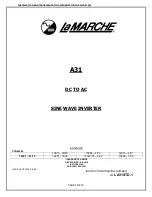
TView Pro AV 1600 User's Manual Rev 1.02
28
For example, the following byte sequences perform the indicated functions:
Output Set to PAL
14
0
13
NTSC/PAL register
0, therefore PAL
<CR>
Decrement Horizontal Size
2
0
13
Horizontal Size
Decrement by 1
<CR>
Delay time between each transmitted character of a command does not matter. Each command will not be completed
until the Carriage Return is received. If incorrect register numbers are given at the start of any command (i. e. byte
with a register value greater than 23), the TView Pro AV 1600 will ignore that byte.
Special caution should be used when using the Save Settings Command (Register 23). Excessive repeated use of this
command (i. e. inside an endless loop) will damage the TView Pro AV 1600's Non-Volatile memory.
3)
The De-Activation Command is given. When a TView Pro AV 1600 is used in an RS-422 system with several
other TView Pro AV 1600s, it will be necessary to De-Activate the currently selected TView Pro AV to issue
commands to another TView Pro AV 1600 in the system. If you are using a single TView Pro AV 1600, it will not be
necessary to De-Activate the TView Pro AV 1600.
The De-Activation Command consists of the character string: RSOFFx (where x is the address of the TView Pro AV
1600). The De-Activation Command (and all other commands) must be followed by a Carriage Return (ASCII
character value of 13 decimal) to be accepted.
The following byte string (using decimal values for ASCII characters) indicates a valid De-Activation Command for a
TView Pro AV previously programmed to be address 3:
82
83
79
70
70
31
13
R
S
O
F
F
3
<CR>
Note that the address number may be delivered as either ASCII, (decimal 51 in the above case) or binary (ETX or
Control C in the above case).
If the TView Pro AV 1600 receives any unexpected input before the reception of the De-Activation Command, it will
ignore it. If it receives an unexpected byte during the transmission of the De-Activation Command, the De-
Activation Command must be re-transmitted (the De-Activation sequence is reset).








































